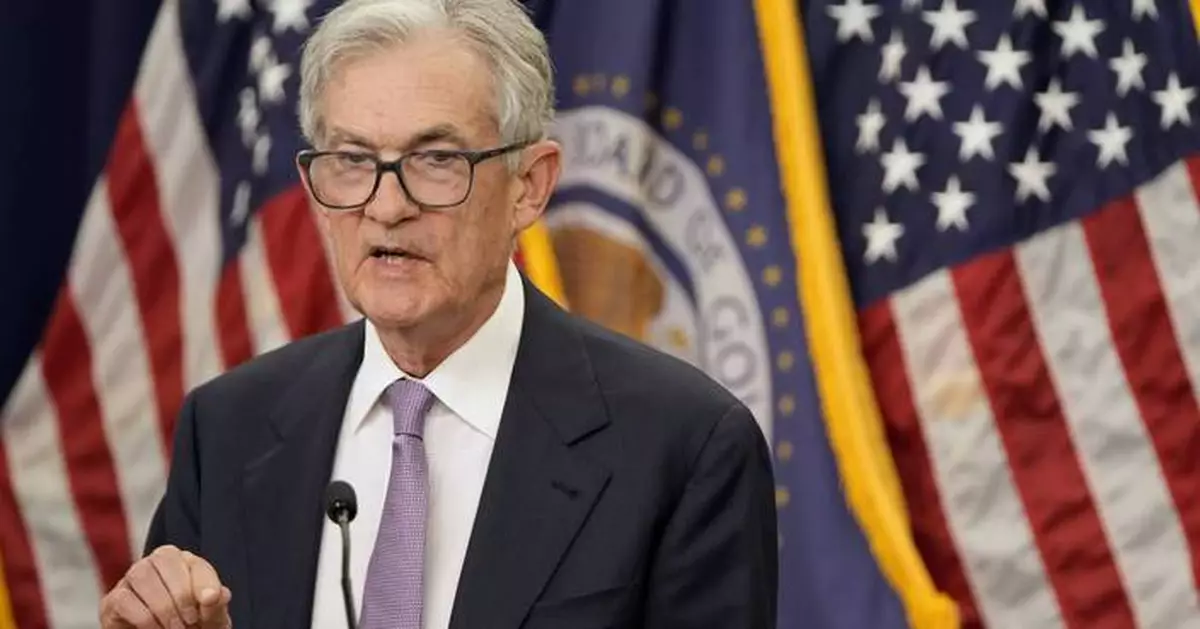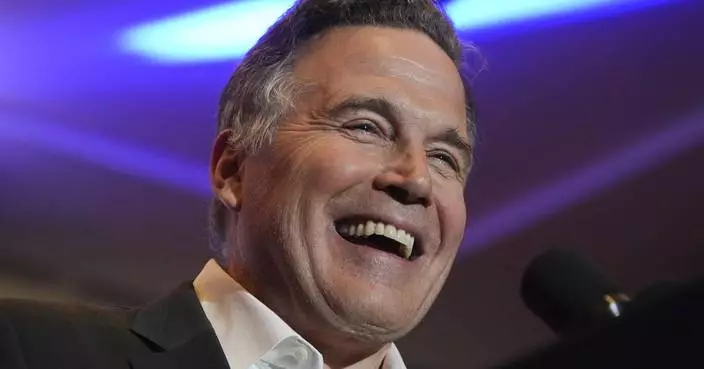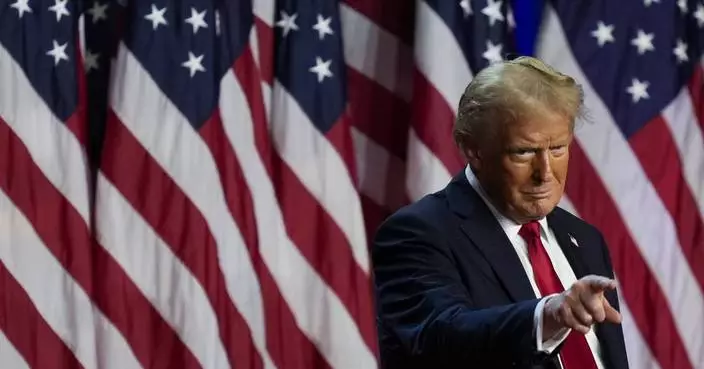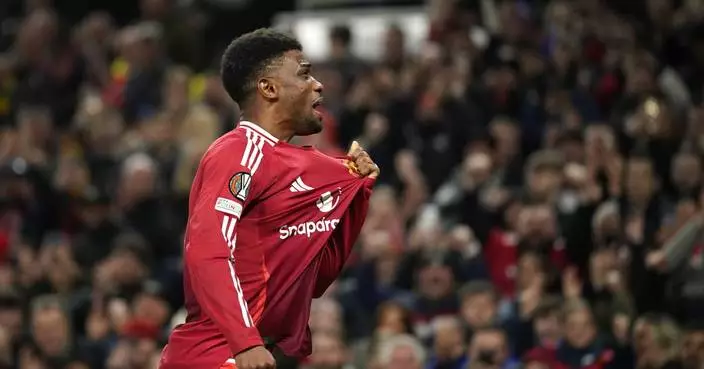WASHINGTON (AP) — The Federal Reserve cut its key interest rate Thursday by a quarter-point in response to the steady decline in the once-high inflation that had angered Americans and helped drive Donald Trump’s presidential election victory this week.
The rate cut follows a larger half-point reduction in September, and it reflects the Fed’s renewed focus on supporting the job market as well as fighting inflation, which now barely exceeds the central bank’s 2% target.
Click to Gallery
Comments by Federal Reserve Chair Jerome Powell appear on a bank of screens on the floor of the New York Stock Exchange, Thursday, Nov. 7, 2024, in New York. (AP Photo/Richard Drew)
A screen at a trading post on the floor of the New York Stock Exchange displays the Federal Reserve interest rate decision, Thursday, Nov. 7, 2024. (AP Photo/Richard Drew)
Federal Reserve Board Chairman Jerome Powell speaks during a news conference at the Federal Reserve in Washington, Thursday, Nov. 7, 2024. (AP Photo/Mark Schiefelbein)
Federal Reserve Board Chairman Jerome Powell speaks during a news conference at the Federal Reserve in Washington, Thursday, Nov. 7, 2024. (AP Photo/Mark Schiefelbein)
Federal Reserve Board Chairman Jerome Powell speaks during a news conference at the Federal Reserve in Washington, Thursday, Nov. 7, 2024. (AP Photo/Mark Schiefelbein)
Federal Reserve Board Chairman Jerome Powell speaks during a news conference at the Federal Reserve in Washington, Thursday, Nov. 7, 2024. (AP Photo/Mark Schiefelbein)
Federal Reserve Board Chairman Jerome Powell speaks during a news conference at the Federal Reserve in Washington, Thursday, Nov. 7, 2024. (AP Photo/Mark Schiefelbein)
Federal Reserve Board Chairman Jerome Powell speaks during a news conference at the Federal Reserve in Washington, Thursday, Nov. 7, 2024. (AP Photo/Mark Schiefelbein)
Asked at a news conference how Trump's election might affect the Fed's policymaking, Chair Jerome Powell said that "in the near term, the election will have no effects on our (interest rate) decisions.”
But Trump’s election, beyond its economic consequences, has raised the specter of meddling by the White House in the Fed’s policy decisions. Trump has argued that as president, he should have a voice in the central bank’s interest rate decisions. The Fed has long guarded its role as an independent agency able to make difficult decisions about borrowing rates, free from political interference. Yet in his previous term in the White House, Trump publicly attacked Powell after the Fed raised rates to fight inflation, and he may do so again.
Asked whether he would resign if Trump asked him to, Powell, who will have a year left in his second four-year term as Fed chair when Trump takes office, replied simply, “No.”
And Powell said that in his view, Trump could not fire or demote him: It would “not be permitted under the law,” he said.
Thursday’s Fed rate cut reduced its benchmark rate to about 4.6%, down from a four-decade high of 5.3%. The Fed had kept its rate that high for more than a year to fight the worst inflation streak in four decades. Annual inflation has since fallen from a 9.1% peak in mid-2022 to a 3 1/2-year low of 2.4% in September.
When its latest policy meeting ended Thursday, the Fed issued a statement noting that the "unemployment rate has moved up but remains low,” and while inflation has fallen closer to the 2% target level, it “remains somewhat elevated.”
After their rate cut in September — their first such move in more than four years — the policymakers had projected that they would make further quarter-point cuts in November and December and four more next year. But with the economy now mostly solid and Wall Street anticipating faster growth, larger budget deficits and higher inflation under a Trump presidency, further rate cuts may have become less likely. Rate cuts by the Fed typically lead over time to lower borrowing costs for consumers and businesses.
Powell declined to be pinned down Thursday on whether the Fed would proceed with an additional quarter-point rate cut in December or the four rate cuts its policymakers penciled in for 2025.
Diane Swonk, chief economist at accounting giant KPMG, said she thought Powell was reluctant to provide hints about the Fed’s next moves because of the uncertainty caused by Trump’s election victory.
“He’s not willing to go too far out ahead of his skis, given how much could change,” she said. “In an environment where you don’t know how promises on the campaign trail translate to actual policies, you don’t want to front-run it.”
Still, Matthew Luzzetti, an economist at Deutsche Bank, said there were signs that the Fed might end up announcing fewer rate cuts next year than many economists expect. The job market and the economy are looking healthier than they appeared in September, when the Fed announced an outsize half-point rate cut.
“Nothing in the economic data,” Luzzetti said, “suggests that the (Fed) has any need to be in a hurry” to get rates down substantially.”
On Thursday, Powell did express confidence that inflation, despite some recent higher-than-expected readings, would keep falling back to the Fed’s target.
“We feel like the story is very consistent with inflation continuing to come down on a bumpy path over the next couple of years, and settling around 2%,” he said.
The economy is clouding the picture by flashing conflicting signals, with growth solid but hiring weakening. Consumer spending, though, has been healthy, fueling concerns that there is no need for the Fed to reduce borrowing costs and that doing so might overstimulate the economy and even re-accelerate inflation.
Financial markets are throwing yet another curve at the Fed: Investors have pushed up Treasury yields since the central bank cut rates in September. The result has been higher borrowing costs throughout the economy, thereby diminishing the benefit to consumers of the Fed’s half-point cut in its benchmark rate, which it announced after its September meeting.
Broader interest rates have risen because investors are anticipating higher inflation, larger federal budget deficits, and faster economic growth under a President-elect Trump. Trump’s plan to impose at least a 10% tariff on all imports, as well as significantly higher taxes on Chinese goods, and to carry out a mass deportation of undocumented immigrants would almost certainly boost inflation. This would make it less likely that the Fed would continue cutting its key rate. Annual inflation as measured by the central bank’s preferred gauge fell to 2.1% in September.
Economists at Goldman Sachs estimate that Trump’s proposed 10% tariff, as well as his proposed taxes on Chinese imports and autos from Mexico, could send inflation back up to about 2.75% to 3% by mid-2026.
The economy grew at a solid annual rate just below 3% over the past six months, while consumer spending — fueled by higher-income shoppers — rose strongly in the July-September quarter.
But companies have scaled back hiring, with many people who are out of work struggling to find jobs. Powell has suggested that the Fed is reducing its key rate in part to bolster the job market. If economic growth continues at a healthy clip and inflation climbs again, though, the central bank will come under pressure to slow or stop its rate cuts.
Asked at his news conference about Americans who are feeling little relief from the pain of high prices and who helped fuel Trump’s victory, Powell said:
“It takes some years of real wage gains for people to feel better, and that’s what we’re trying to create, and I think we’re well on the road to creating that. Inflation has come way down, the economy is still strong here, wages are moving up, but at a sustainable level.
“I think what needs to happen is happening, and for the most part has happened, but it will be some time before people regain their confidence and feel that.”
AP Business Writer Alex Veiga contributed to this report from Los Angeles.

Comments by Federal Reserve Chair Jerome Powell appear on a bank of screens on the floor of the New York Stock Exchange, Thursday, Nov. 7, 2024, in New York. (AP Photo/Richard Drew)

A screen at a trading post on the floor of the New York Stock Exchange displays the Federal Reserve interest rate decision, Thursday, Nov. 7, 2024. (AP Photo/Richard Drew)
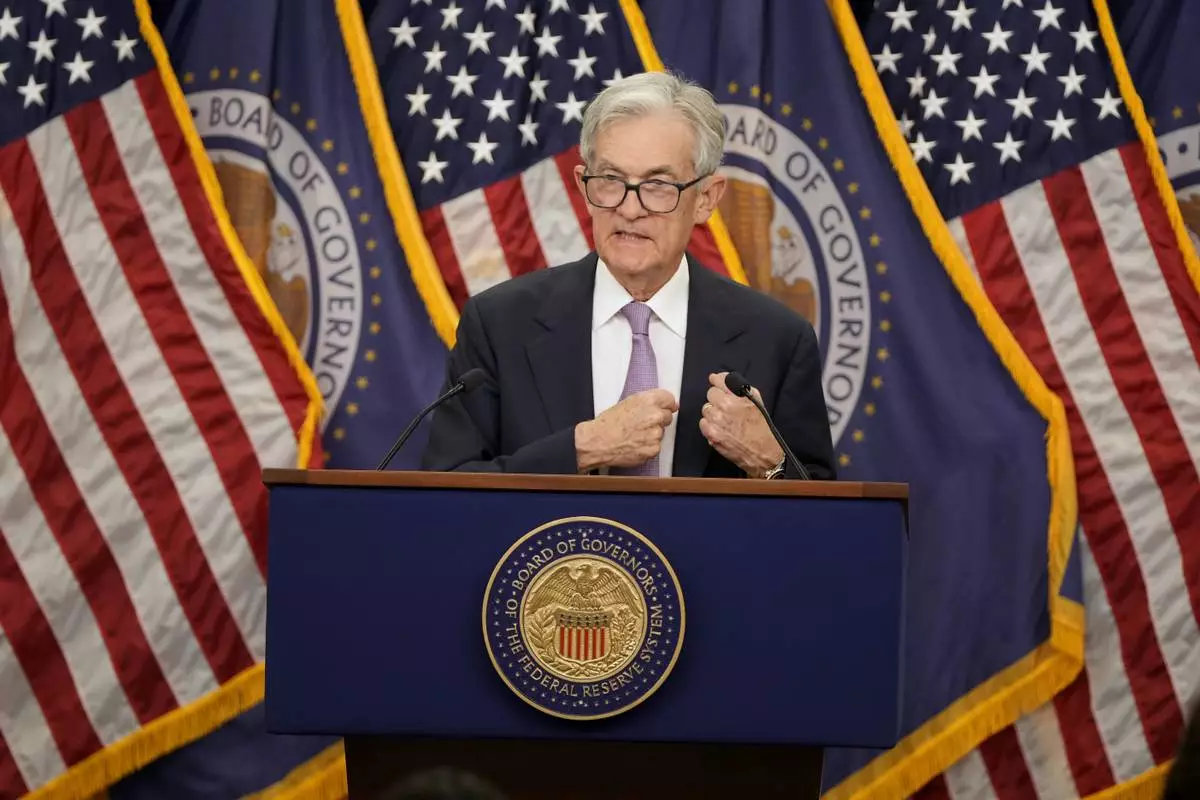
Federal Reserve Board Chairman Jerome Powell speaks during a news conference at the Federal Reserve in Washington, Thursday, Nov. 7, 2024. (AP Photo/Mark Schiefelbein)
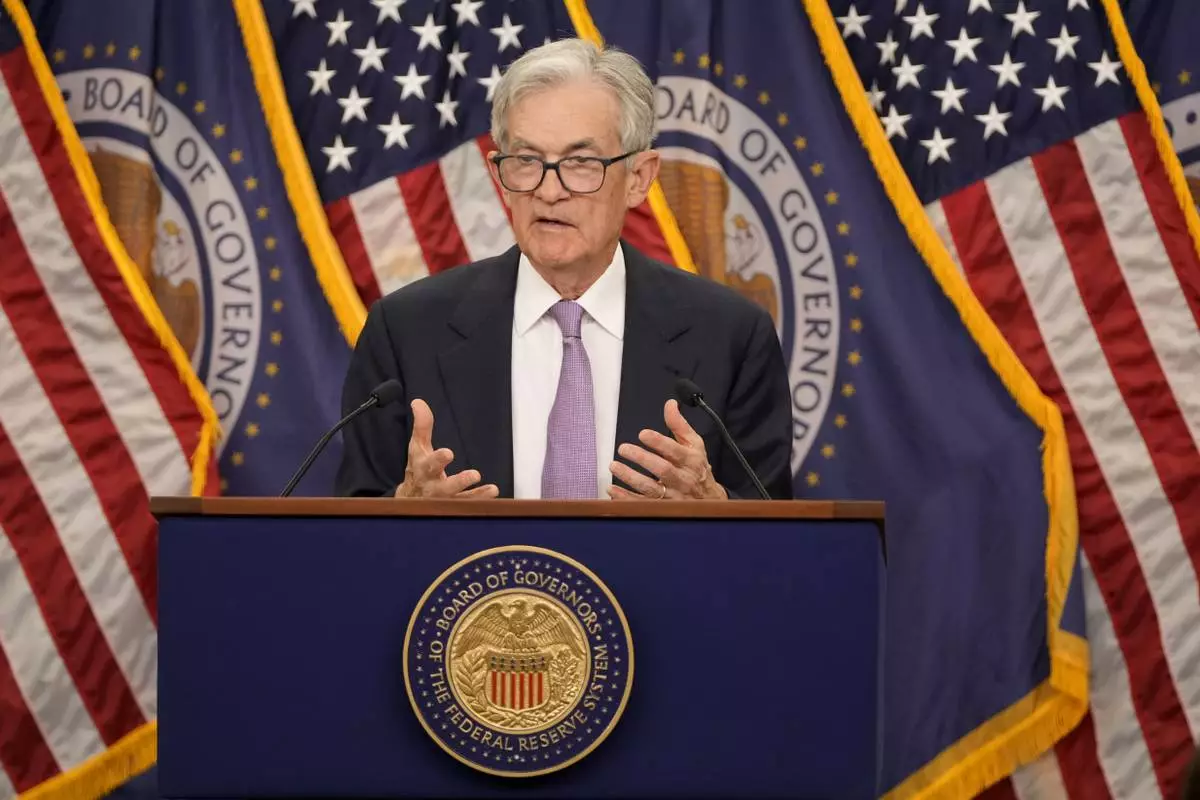
Federal Reserve Board Chairman Jerome Powell speaks during a news conference at the Federal Reserve in Washington, Thursday, Nov. 7, 2024. (AP Photo/Mark Schiefelbein)
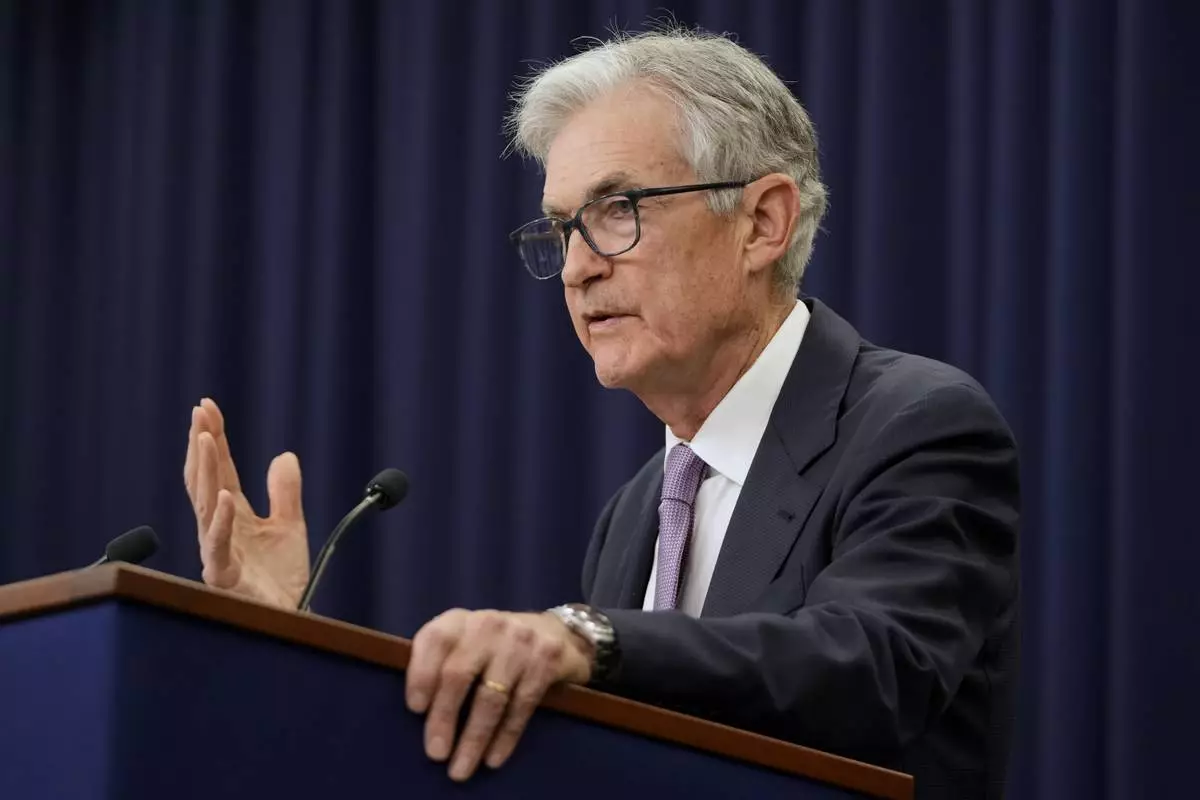
Federal Reserve Board Chairman Jerome Powell speaks during a news conference at the Federal Reserve in Washington, Thursday, Nov. 7, 2024. (AP Photo/Mark Schiefelbein)
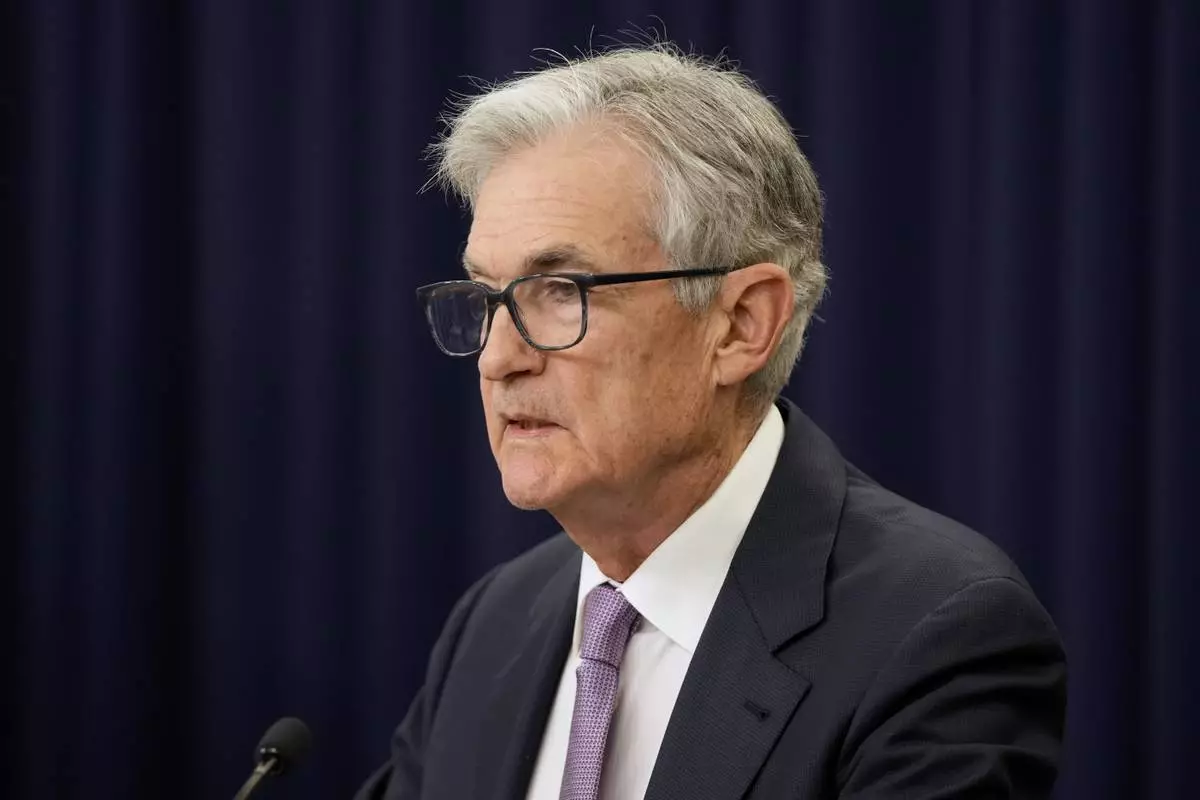
Federal Reserve Board Chairman Jerome Powell speaks during a news conference at the Federal Reserve in Washington, Thursday, Nov. 7, 2024. (AP Photo/Mark Schiefelbein)
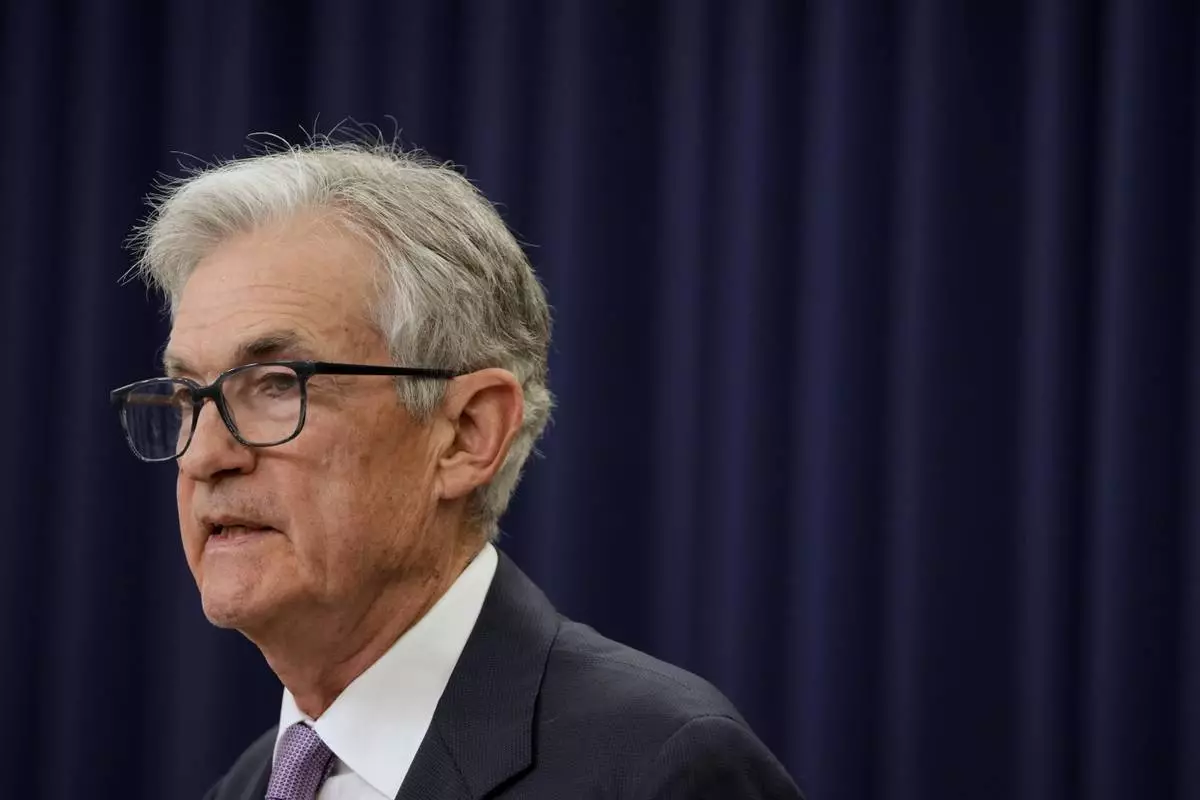
Federal Reserve Board Chairman Jerome Powell speaks during a news conference at the Federal Reserve in Washington, Thursday, Nov. 7, 2024. (AP Photo/Mark Schiefelbein)
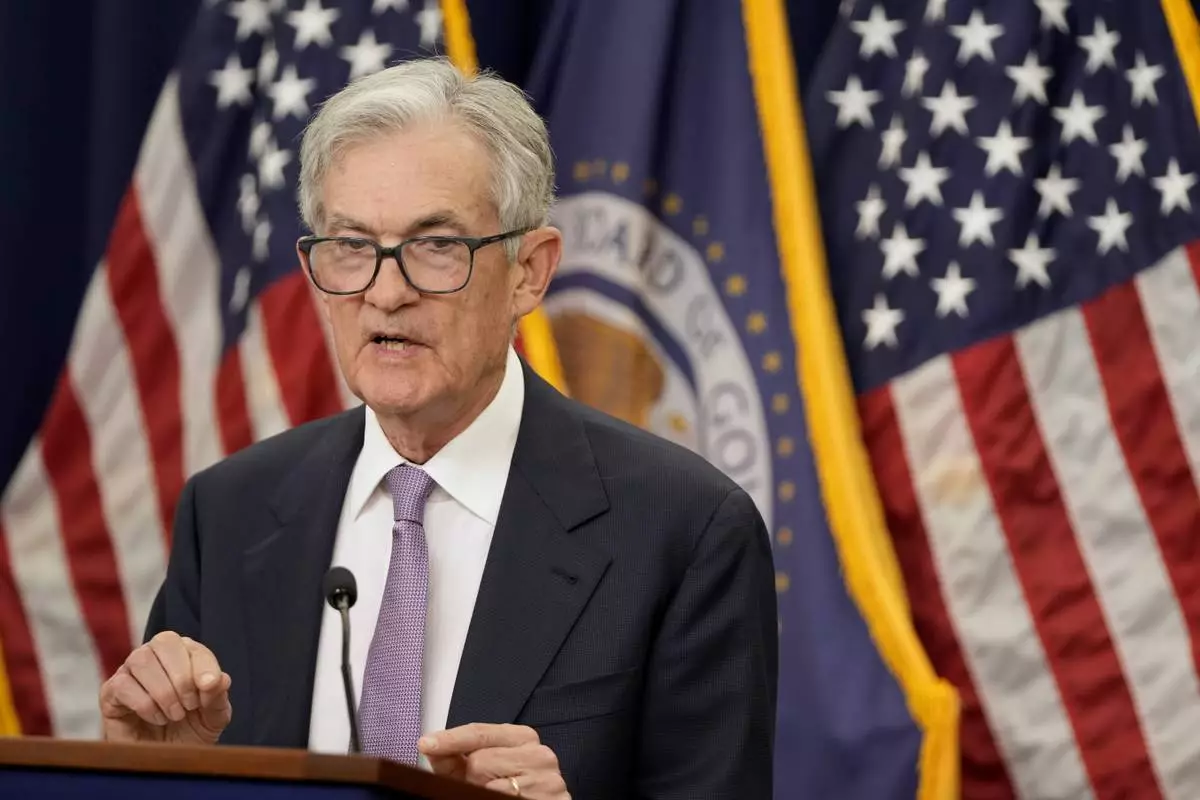
Federal Reserve Board Chairman Jerome Powell speaks during a news conference at the Federal Reserve in Washington, Thursday, Nov. 7, 2024. (AP Photo/Mark Schiefelbein)
ASHBURN, Va. (AP) — The odds were against the Pittsburgh Steelers and Washington Commanders making the playoffs before the season started, for various reasons on either side.
They meet up just past the midway point in a showdown of first-place teams that have exceeded expectations and even added at the trade deadline to improve their odds. The Steelers (6-2) acquired receiver Mike Williams and edge rusher Preston Smith to fill areas of need, the Commanders (7-2) got cornerback Marshon Lattimore, and their game Sunday at Washington is a chance to see how they stack up against each other.
“It’s a tough matchup and another good test for us,” Commanders receiver Noah Brown said. “We’re excited about it.”
While Lattimore’s status is murky because of a hamstring injury, Williams and Smith could play — and the Steelers are plenty excited about what they bring to a group that has already set a high standard for what a successful season looks like.
“We know we have to win playoff games,” tight end Pat Freiermuth said. “That was our goal coming into this year, so any time the front office can add pieces to that, if they can help us win, obviously it’s cool. But we knew from the start we were all in to go win this thing this year.”
Pittsburgh hasn't won a playoff game since 2016 but has reached the postseason in two of the past three years and 11 times under coach Mike Tomlin. Washington has just one appearance since 2016 and hasn't won a playoff game since 2005.
This looked like a rebuilding season around rookie quarterback Jayden Daniels. Instead, Daniels has been one of the NFL's best players to leap into the MVP conversation, general manager Adam Peters' roster overhaul has paid immediate dividends, and this is Washington's best nine-game start since 1996. Six-time All-Pro linebacker Bobby Wagner, one of a bevy of new additions in free agency, isn't sure if playing the Steelers is a measuring stick but can't wait to get on the field and find out.
“I think it’s more fun,” said Wagner, who played with Pittsburgh QB Russell Wilson for a decade with Seattle. “The Steelers is a really respected organization, and so being able to play against somebody like that and being able to play against a coach like Mike Tomlin and things of that nature, it’s more so like, ‘OK, this game’s going to be fun.’”
The Commanders are 3-point favorites on BetMGM Sportsbook.
The Steelers have dominated rookie quarterbacks through the years, including a 25-6 mark under Tomlin. That list includes an easy victory over Robert Griffin III and Washington in 2012, as well as a win against Bo Nix and the Denver Broncos in Week 2.
Enter the electric Daniels, who has Tomlin’s full attention.
The NFL’s longest-tenured coach doesn’t think Daniels is a typical first-year player, pointing to Daniels’ ability to extend plays and make productive decisions at the end of them.
“He’s been able to extract the good from those moments while minimizing the bad,” Tomlin said. “I just think that speaks to his savvy and experience. ... This guy has been a franchise quarterback at two different universities.”
Daniels is several games into his pro career — nine, officially, but he missed the vast majority of one with a rib injury. Wilson is in his 13th season, now with his third team, and Daniels admires the almost-36-year-old vet's playmaking abilities.
“I’ve been seeing Russ pretty much his whole career,” said Daniels, who continues practicing and playing through sore ribs but hasn’t slowed down. “He throws a really good deep ball, very accurate. Overall, just his leadership and how he treats his people on and off the field, that’s something that stands out.”
Commanders rookie defensive tackle Johnny Newton, who grew up a Seahawks fan rooting for Wilson, called him smart and savvy.
“He has a feel of everything,” Newton said.
Pittsburgh’s vaunted run defense took a hit against the New York Giants during a 28-16 victory on Oct. 28, allowing a season-high 157 yards on the ground in a performance that left veteran defensive tackle Cam Heyward fuming.
The Steelers, coming off their bye, need to make sure the shaky play at the line of scrimmage was an anomaly with their second-half schedule filled with teams that like to run the ball, including Washington, Baltimore (twice) and Philadelphia.
Tomlin seems less concerned about the opponents than he does his defense returning to the form it showed earlier in the season.
“We don’t care about the Joneses, man,” Tomlin said. “Our story is our story. We got an agenda and we’re trying to live it, and when we don’t meet it, we’re thumb-pointers. We’re the guys that look in the mirror.”
AP Sports Writer Will Graves in Pittsburgh contributed to this report.
AP NFL: https://apnews.com/hub/NFL

Pittsburgh Steelers quarterback Russell Wilson (3) throws during the first half of an NFL football game against the New York Giants, Monday, Oct. 28, 2024, in Pittsburgh. (AP Photo/Gene J. Puskar)

Washington Commanders owner Josh Harris walks off the field after an NFL football game against the New York Giants, Sunday, Nov. 3, 2024, in East Rutherford, N.J. (AP Photo/John Munson)
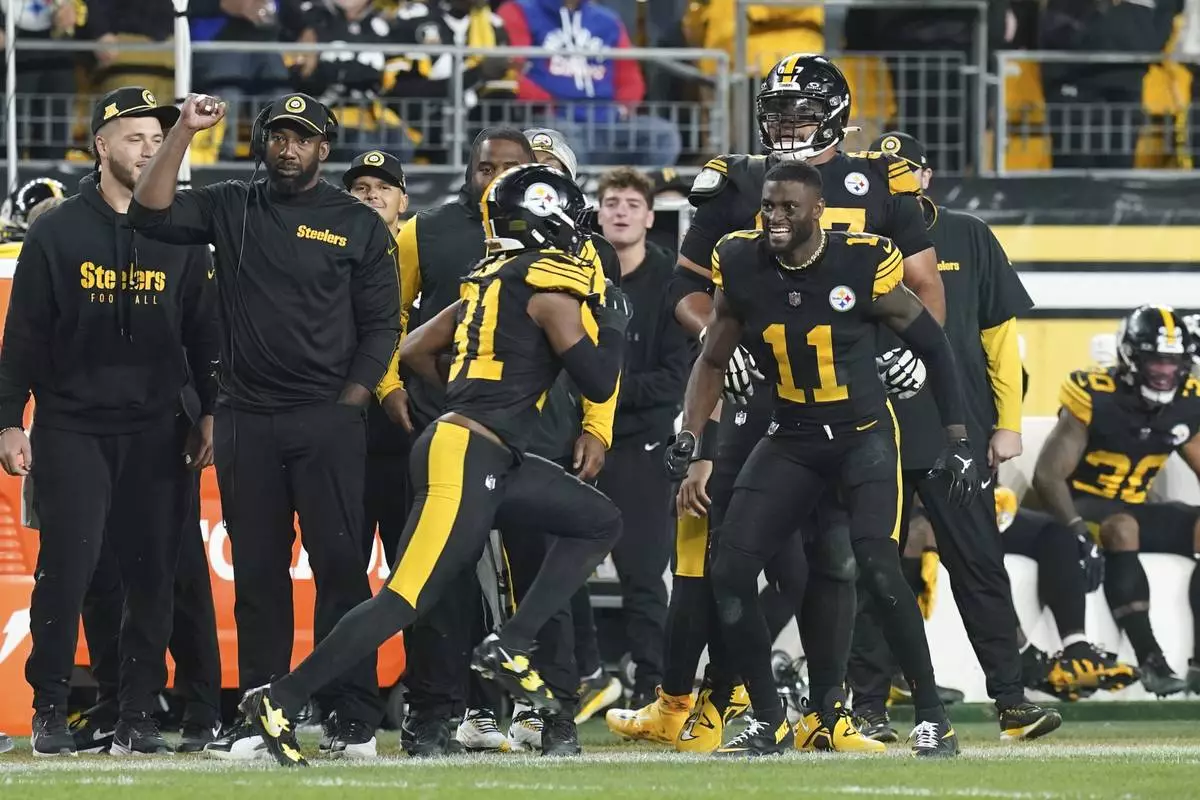
Pittsburgh Steelers cornerback Beanie Bishop Jr. (31) runs back with an intercepted pass during the second half of an NFL football game against the New York Giants, Monday, Oct. 28, 2024, in Pittsburgh. (AP Photo/Matt Freed)

Washington Commanders quarterback Jayden Daniels (5) carries the ball against the New York Giants during the second quarter of an NFL football game, Sunday, Nov. 3, 2024, in East Rutherford, N.J. (AP Photo/John Munson)

Pittsburgh Steelers wide receiver Calvin Austin III, right, returns a punt for a touchdown during the second half of an NFL football game against the New York Giants Monday, Oct. 28, 2024, in Pittsburgh. (AP Photo/Gene J. Puskar)

Washington Commanders running back Chris Rodriguez Jr. (23) celebrates with tight end John Bates (87) after gaining a first down against the New York Giants during the fourth quarter of an NFL football game, Sunday, Nov. 3, 2024, in East Rutherford, N.J. (AP Photo/Seth Wenig)

Pittsburgh Steelers head coach Mike Tomlin fields questions after an NFL football game against the New York Giants, Monday, Oct. 28, 2024, in Pittsburgh. (AP Photo/Gene J. Puskar)
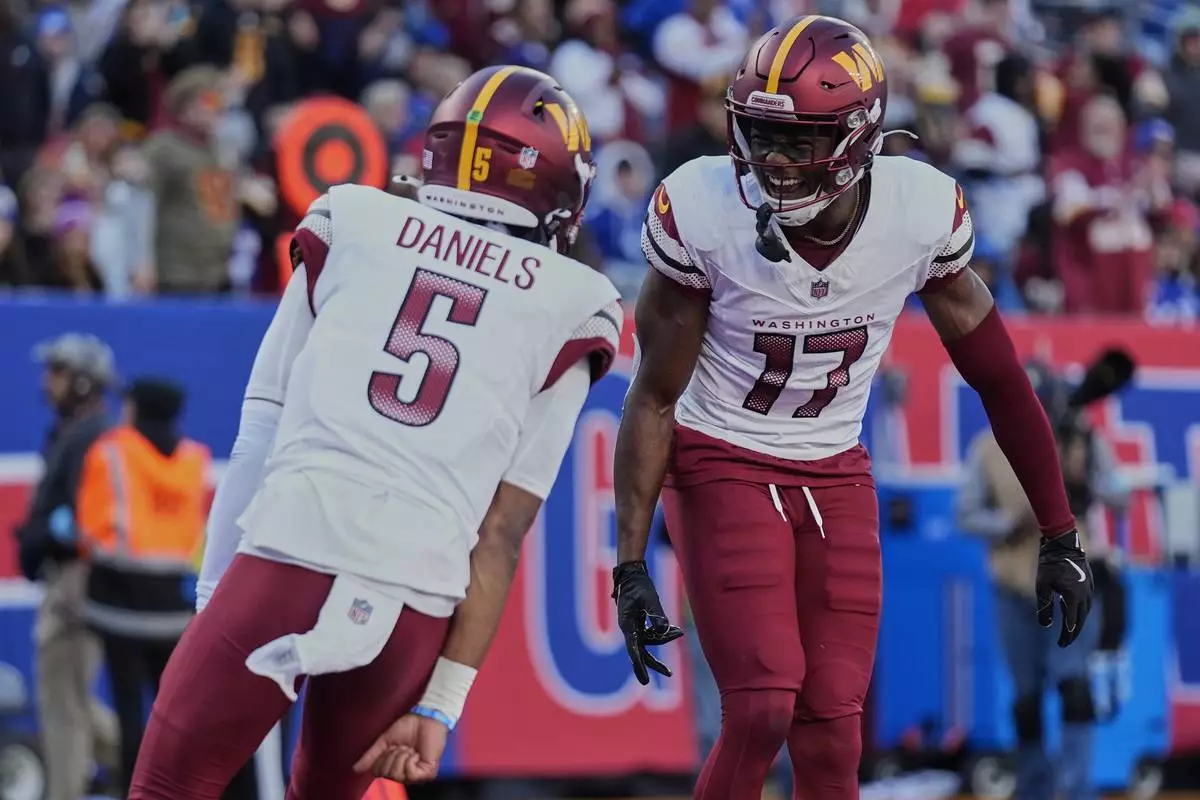
Washington Commanders wide receiver Terry McLaurin (17) celebrates with quarterback Jayden Daniels (5) after scoring a touchdown against the New York Giants during the second quarter of an NFL football game, Sunday, Nov. 3, 2024, in East Rutherford, N.J. (AP Photo/Seth Wenig)

Pittsburgh Steelers wide receiver Calvin Austin III (19) celebrates his touchdown catch with teammates during the second half of an NFL football game against the New York Giants, Monday, Oct. 28, 2024, in Pittsburgh. (AP Photo/Gene J. Puskar)










